Countless times I have suffered from a smoky bonfire. When you are back home things are relatively okay, although outdoors you would have to carry the stinky clothes for an extended period. Over the years, I’ve learned a few techniques on that topic, and now I am ready to share it all with you. Let’s try to understand what makes a campfire smoke so much and how actually to solve the issue.
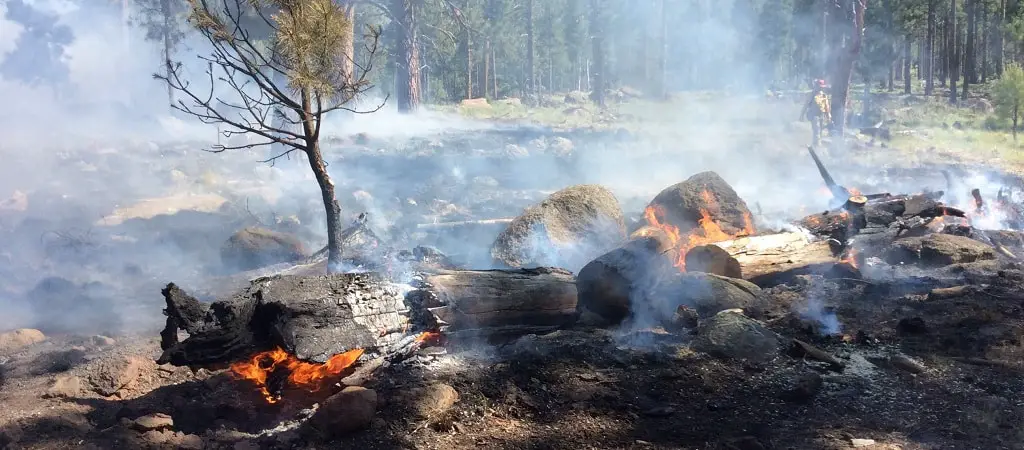
You campfire tends to smoke so much because of the following:
- Inadequate airflow – make sure that the flame is not suffocated, build it in the shape of a teepee if possible.
- You are using greenwood that is freshly cut – stick to old fallen branches.
- The wood you are using is old, although it is wet; stick to dry logs instead.
- You are using the wrong materials; barks, leaves, plastic, softwoods, etc. Stick to hardwoods such as maple and oak
- You have built your campfire wrong; avoid thick piles, for instance. Place the wood gradually and make sure you ignite the bonfire from the bottom.
- The campfire stands on green grass or plants – pick a better fireplace.
1. Poor Airflow
Every fire needs air (oxygen), in addition to fuel and heat. So, even with dry wood and enough heat to keep the logs blazing, lack of enough air can result in your fire generating a lot of smoke due to incomplete combustion.
This is especially an issue in indoor settings where there might not be enough air circulation to give the fire the air it needs to burn the wood completely.
How Can an Outdoor Campfire Lack Enough Air?
It can happen, depending on how you have set up your fire. For instance, if the kindling material is covered in firewood, then it might not get enough air, and that can result in the creation of too much smoke.
One way to resolve this problem is to use a few pieces of wood to build a fire, then add on to them slowly as the fire grows in strength.
Otherwise, if the flame is somewhat covered up and lacks proper air circulation, your campfire will give you a lot of smoke, and it will be due to incomplete combustion.
Organize Your Wood
Many seasoned campers recommend that you make a teepee style kind of fire to avoid the problem of inadequate air. In this case, the fire has an open center.
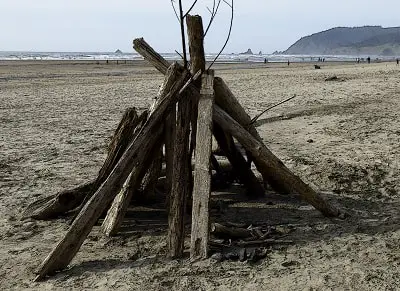
This design allows for better air circulation, which is sure to keep the fire burning since air will flow freely. You can also try arranging the firewood in a square configuration around the kindling, and this is called the Lincoln log method.
Another secret to building an impressive smokeless fire is to ensure that there are spaces between the burning logs. This ensures that the air circulation within the flame is excellent, which will reduce the chances of it becoming a smoky campfire due to thin air.
Still, keep in mind that excessive airflow would haste burning and wood consumption. In fact, I’ve written a whole article on that issue when I discussed how to keep a campfire burn all night. I highly suggest that you read it if you will be facing cold nights in the future.
The Dakota Fire
You can also create a Dakota fire, whereby you dig two pits which are linked by a small tunnel beneath them. The light is created in one of the holes, while the other pit supplies fresh air.
That will ensure that the air burns with enough air and therefore does not generate any smoke. This fire will burn a lot longer as well, which means it can help you save on fuel, and you can use it for cooking more efficiently.
2. You Are Using Green Wood
Greenwood can result in your campfire, producing a lot of smoke. Green does not mean that the firewood is green in color, but that wood that has been cut of a live tree very recently.
Freshly cut wood has a lot of moisture in it, and this makes it very smoky when used to build a fire. Before such timber is used, it should be left to dry over time.
However, to dry it out much faster, it can be dried in a kiln. Some people think that thin branches cannot produce a lot of smoke, even if they are not completely dry.
But that can be a huge mistake, as one small stick can produce excessive amounts of smoke. Therefore, you have to avoid green plant material at all costs, including leaves, to build a smokeless fire.
3. You Are Using Wet Wood
It is possible to use damp logs to get your fire going. I’ve previously written an in-depth article on that matter explaining how to light wet firewood.
Nevertheless, wetness in firewood can result in a flame which produces a lot of smoke. Dry wood catches fire quickly and does not create as much smoke, especially when it has been dried in a kiln.
Why Does it Happen?
With wet wood, there is usually an extra step involved because before the damp wood can start burning, it has to lose the moisture in it first, and that is why it generates so much smoke. So, until the wood loses the moisture in it, it will keep producing a lot of smoke.
That is why you should always use dry wood when building a campfire to ensure that the fire burns more efficiently.
To guarantee you keep having dry wood for your bonfire, you should even consider carrying your own firewood as you go camping, mainly when the weather is a little wet and finding dry wood at the camp is something of a challenge.
Store it Properly
You should also be careful about where you store your firewood. Wet outdoors will result in the kindling getting wet as well, and using that wood to build a fire could be a big nightmare as the smoke can get intolerable. So, try storing your firewood in a covered area where it does not get exposed to rain.
Another way to ensure you have dry wood is to keep it close to a fire, but not so close that it can catch fire. This can make it dry out completely so that it does not produce as much smoke.
Sometimes, a single wet piece of firewood might be the reason your fire has so much smoke, and taking it out of the bonfire might help. Such wood will sometimes produce a hissing sound, and extinguishing it can resolve the smoke problem completely.
Nevertheless, if you have no choice, it is better to have a smoky fire than nothing at all. For that, I highly suggest that you read my article on how to keep a fire going in the rain; I’ve spent hours pouring through the data on this one.
4. Avoid Some Types of Wood
Some kinds of wood, whether dry or not, will produce a lot of smoke. That is their nature, and there is little you can do about it. Therefore, the best thing is to get firewood from woods that have a reputation for producing less smoke when used to build a fire.
Getting the wrong type of wood can be a disaster as some types of wood can even produce bitter smoke that will leave everyone around the campfire in tears.
Therefore, always consider the type of wood you are burning, because the airflow might not be the issue or the dryness of the logs. The type of plant material you are burning might be the reason your fire will not stop making so much smoke.
That said, you should also avoid putting some types of materials into the fire, as they can result in the generation of a lot of smoke.
For instance, leaves, though dry, can make a lot of smoke. Tree barks are also generally bad as they tend to create a lot of smoke. However, some types of barks, such as birch bark, are perfect as they don’t produce smoky campfires.
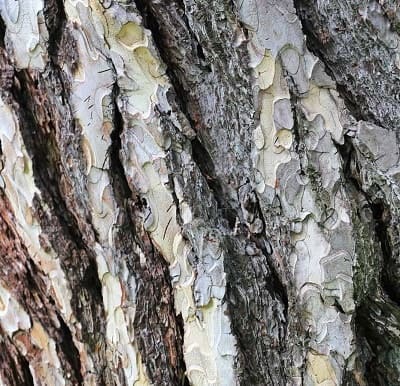
Just as a guide, understand that softwoods such as pine produce more smoke than hardwoods. In fact, trees such as maple and oak tend to burn hotter and without much smoke.
In case you didn’t know, the hotter the flame, the less the smoke it generates. So, go for hardwood firewood, and you will have less smoke to deal with in addition to creating hotter fires.
5. You Haven’t Built a Proper Smokeless Fire
Don’t pile a vast amount of logs as you are trying to build a fire. That will smother the pieces of wood with the flame, and you will end up with a smoky fire.
You can start with a few pieces of wood, and then add one or two additional pieces at a time depending on how small or big the logs are.
Generally, ensure that all the pieces of firewood on the fire pit have caught fire before adding more pieces. So, even if your goal is to build a huge campfire, start out small and add the extra pieces of wood as time goes by and you will not have to deal with as much smoke.
Additionally, when kindling the fire, avoid compacting the material as this will hinder air flow and result in smoke even though you are using dry logs to build a fire.
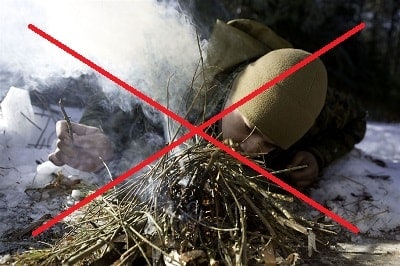
That said, avoid kindling material that can generate toxic fumes, for instance, plastics. Not only can such materials produce a lot of smoke, but also create smoke that can be hazardous to your health.
Furthermore, you should ignite the fire from below, not from above the kindling material. You should also encourage the flame to spread around as much as possible by blowing on it until there is a consistent blaze.
Additionally, as you add firewood after your fire has started, start with smaller and thinner pieces of wood before you start adding more substantial pieces of wood.
Also, understand that all fires generate some smoke. But in some cases, the smoke is not even noticeable, and we often call that a smokeless fire.
Therefore, since some smoke might be likely to occur at some time when the campfire is alive, you can do something to prevent the smoke from hitting you in the face.
For instance, you can place a large rock just on the other end of the fire, and since heat will usually rise from there, so will be the smoke, and that will keep it away from you, and you can enjoy your smokeless’ campfire.
If you go with that method, please make sure that the stone you choose is not smooth nor been next to a water source; otherwise, it might explode.
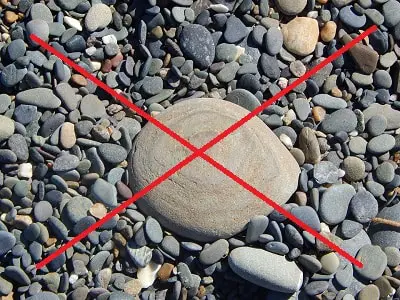
6. Poor Choice of Fireplace
Even though you might have perfect firewood, and have chosen the best kindling material and managed to ensure that there is adequate airflow in the fire, you might still end up with a smoky campfire if you decide to build a fire on the wrong fireplace.
So, before you build a fire, ensure that you clear the place the flame will go into to ensure it does not have materials that might cause smoke once the ignition starts.
For instance, don’t build a fire on top of green glass, or above plant materials, some of which might be green or wet. Even ashes from a previous fire should be cleared so that the fireplace is relatively clear before you start making a fresh campfire.
Mostly, you should prepare a relatively large area so that no nearby materials are likely to catch fire and start producing smoke.
Is Campfire Smoke Bad For Your Lungs?
On itself, the smoke produced from your bonfire shouldn’t do any harm. Nevertheless, it could be more problematic when you already have underlying health conditions, such as asthma or COPD. The reason for that is that the smoke carries small particles which might irritate your airways.
If you have asthma, there is a high chance these particles would induce an episode with shortness of breath or even worse. COPD patients might suffer from exacerbations, followed by coughs and difficulties in breathing.
If you fall into these two categories, you should avoid the smoke as hard as you can. Try sitting far away from the bonfire and switch places contrary to the wind. In general, I would say you shouldn’t participate in campfire activities if you already have a problematic health condition.
How do You Get Smoke From a Campfire Out of Clothes?
If you suffer from a smoky fire, there is a good chance its smell had stuck to you. To get the smoke out of your clothes, you should first ventilate it outside, especially when you are camping with a tent.
You most certainly shouldn’t sleep with these clothes on inside a closed shelter; I’ve suffered from it quite a lot on my previous adventures. Second, you should launder your clothing with detergent for an extended period. You could also use a softener with a strong perfume in it.
If the smell still hasn’t gone out, you could launder your clothes one more time while adding some baking soda or vinegar. These two products are excellent in removing smells and might serve you, particularly if you wish to remove mold and mildew from your tent’s canvas.
Conclusions
It is possible to build a campfire which doesn’t smoke much, although you should pay attention to the reasons that might cause it.
The main issues would be picking the right material and the proper spot. Also, it is essential that you place the wood correctly, so it doesn’t suffocate the flame and results with ever more smoke.
Do not underestimate that issue, it might end up with serious health complications, especially when you already have an underlying lung disease, such as asthma or COPD.
If the smoke still had been an issue, there are ways to remove the smell from your clothes. First, make sure that you ventilate them. Then, laundry the clothing with a perfumed softener. You could also use vinegar and baking soda to get rid of it.
I hope my article had answered your question. If you have any insights of your own – let me know all about them by leaving a comment below!

